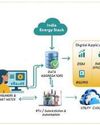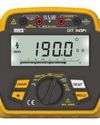Versuchen GOLD - Frei
Al powers hydro operations, leading to efficiency and RE integration
EPR Magazine (Electrical & Power Review)
|October 2025
Hydro power follows the load in the grid, unlike solar and wind power sources, and provides the inertia to withstand the grid fluctuations. This reason will establish hydro power as a sustainable relevance for an appropriate energy mix and contribute to achieving carbon neutrality by 2070.

India is endowed with a hydro power potential of around 1,45,320 MW from around 592 hydroelectric schemes, out of which approximately 49628.17 MW has been harnessed till now in the form of large hydro projects, which constitute approximately 10 per cent of the total installed capacity. The power mix as of August 2025 is 49 percent from thermal power, 38.3 percent from renewables (solar, wind, and small hydro), 10 percent from large hydro, and 1.8 percent from nuclear power generation out of the total installed capacity, which stands at 502 GW.
According to the World Resources Institute Climate Analysis Indicators Tool (WRI CAIT), India's GHG profile in 2014 was dominated by emissions from the energy sector, which accounted for 68.7 percent of total emissions. Within the energy sector, 49 percent of emissions were due to electricity and heat generation. Hence, India is on a mission to reduce GHG emissions by increasing the generation from renewable sources, such as solar, wind, and hydro, which have now been declared renewable.
The country has set ambitious clean energy goals, targeting 500 GW of non-fossil fuel installed capacity by 2030, with 50 percent of generation capacity coming from renewables (including hydro), and to reach net-zero emissions by 2070. By 2032, the installed capacity of the country would reach around 900 GW, out of which a large hydro share with an installed capacity of 62 GW will be 7 percent. However, in order to complement the huge addition of Variable Renewable Energy (VRE) sources (solar and wind), Pumped Storage Hydro Projects would be required to the tune of 27 GW as per the NEP (2022-2032), which is about 3 percent. Hence, hydro mix by 2030 would be standing at 10 percent and solar at 40 percent, and wind at 13 percent. Thermal generation would be limited to around 32 percent.

Diese Geschichte stammt aus der October 2025-Ausgabe von EPR Magazine (Electrical & Power Review).
Abonnieren Sie Magzter GOLD, um auf Tausende kuratierter Premium-Geschichten und über 9.000 Zeitschriften und Zeitungen zuzugreifen.
Sie sind bereits Abonnent? Anmelden
WEITERE GESCHICHTEN VON EPR Magazine (Electrical & Power Review)

EPR Magazine (Electrical & Power Review)
Capacity surge powers demand for advanced wires and cables
By FY26, the wires and cables industry is expected to tap around 10,000 km of interstate transmission installation, apart from rail and metro capex.
2 mins
November 2025

EPR Magazine (Electrical & Power Review)
From smart meters to automation in generation, transmission, substation ops
The transition toward a digital and consumer-centric grid began with the nationwide rollout of smart meters, enabling accurate billing, two-way communication, and demand side visibility. The success of this transformation owes much to indigenous manufacturing, with AEW emerging as one of India's largest suppliers of smart meters under RDSS and DISCOM modernisation projects.
2 mins
November 2025

EPR Magazine (Electrical & Power Review)
ELECTRIFICATION INTELLIGENCE
The transition is vital as India advances toward its 2070 net-zero target, where the interplay between renewable integration and grid flexibility will determine success.
5 mins
November 2025

EPR Magazine (Electrical & Power Review)
INDIA IS IN THE NEXT PHASE OF TRANSMISSION AND SUBSTATION GROWTH
India's power grid is in the middle of a major upgrade, transmission corridors are being expanded, substations are going digital, and utilities are adopting smarter control systems, all with the single goal of ensuring reliable and efficient power delivery for growing India.
6 mins
November 2025

EPR Magazine (Electrical & Power Review)
Sharmila Kumbhat redefining the lighting industry and inspiring future leaders
Kumbhat introduced innovative design concepts and streamlined operations, transforming K-Lite into a modern, system-driven entity.
3 mins
November 2025

EPR Magazine (Electrical & Power Review)
KUSAM-MECO plans 50% production increase to meet energy demands
KUSAM-MECO, a leading Indian manufacturer of test and measuring instruments, is expanding its production, quality systems, and global reach to meet rising energy demands. Let us hear from Chandmal Goliya to know more.
1 mins
November 2025

EPR Magazine (Electrical & Power Review)
HIKMICRO AI Acoustic Imager for efficient air leak detection
Leaks in compressed air systems, often caused by ageing infrastructure, loose fittings, or other mechanical issues, are common and can lead to significant energy waste and operational disruptions.
1 mins
November 2025
EPR Magazine (Electrical & Power Review)
RM Controls & VR Engineering catalysts for modernisation, clean energy integration
The power sector in India is rapidly evolving, which demands adaptive engineering solutions. Following the trend, the duo RM Controls and VR Engineering Consultancy Services are advancing on multiple fronts. Amit Varshney shares more insights. Let us hear him.
2 mins
November 2025

EPR Magazine (Electrical & Power Review)
SVG technology delivers game- changing performance advantages
Static VAR Generators are reaching cost parity with traditional capacitors, marking a crucial shift in power factor correction that delivers superior performance for modern industrial applications.
1 mins
November 2025

EPR Magazine (Electrical & Power Review)
MECO Instruments addressing capacity surge with advanced T&M devices
New technologies are reshaping the electrical grid into an intelligent, adaptive network capable of handling modern complexities and solar and wind energy sources. Let us know more from Kishorkumar Thakare, Marketing Manager (South India) of MECO Instruments.
2 mins
November 2025
Listen
Translate
Change font size

